| Home |
| Acknowledgments |
| Conventions |
| Glossary |
| Maps |
| References |
| Links |
| Articles |
| Thumbnails |
| Species
list |
| Family |
| Next
species |
Additional Photos

underside

sensory bristles

short "tail"

long "tail"

rounded "tail"

broken lines
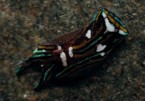
young, 2.8 mm
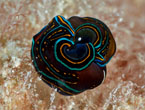
mating
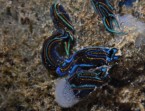
with egg masses
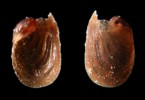
shell
_______________
GALLERY

Chelidonura hirundinina (Quoy & Gaimard, 1833)
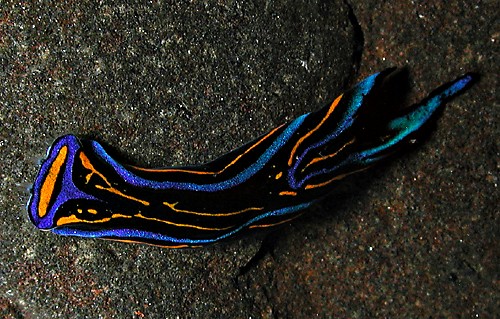
| Maximum size: about 20 mm
(excluding
"tail"). Identification: This is a black species variably decorated with orange and blue/green lines. Portions of the blue/green lines may be replaced by white in some animals. The most consistent characteristic is the ring of blue/green surrounding an orange bar on the top of the head with a central extension onto the notum. The width of the lines is variable. The "tails" are also highly variable ranging from short and symmetrical to long and asymmetrical. In asymmetrical animals, either the right or left hand "tail" may be longer in contrast to most Chelidonura spp (perhaps reflecting loss to predators and regeneration?). Some "tails" may also have rounded rather than acute tips. (Note 1) (Note 2) Natural history: Chelidonura hirundinina is a common diurnal species found in protected to highly exposed locations. It occurs in rocky habitats and Halimeda kanaloana beds from < 1 m (3 ft) to at least 30 m (100 ft). It can also be found in tide pools. Kay (1979) reports it as occurring on Spyridia and Padina but we haven't noticed any substrate preference. It probably feeds on small acoelomate flatworms. (Note 3). A fringe of sensory hairs at the front of the head is used to detect prey and it secretes a yellowish fluid when disturbed. In dishes, its egg masses are small, irregular white clumps composed of an irregular string. However, when laid in the field, they are "spun" around the body from the head backwards and probably retain a sack-like form (presumably because their sticky surfaces collect detritus for reinforcement). (Note 4) Occasionally, they may form mating aggregations (see photo). Hatching occurs in about four days in the laboratory. (Note 5) Distribution: Big Island, Maui, Oahu, Kauai, French Frigate Shoals, Laysan, (Note 6) Lisianski, and Midway (also Johnston Atoll): circumtropical. Taxonomic notes: It is referred to as the "blue swallowtail slug" in Hoover, 1998 & 2006. The right hand drawing labeled C. hirundinina in Kay, 1979 is actually Chelidonura alisonae, instead. Photo: CP: Mala Wharf, Maui; May 2, 2006 Observations and comments: Note 1: Animals from highly exposed habitats such as north shore tide pools tend to have short symmetrical "tails," fine lines and extensive white pigment. Animals from protected sites such as off-shore Halimeda kanaloana beds tend to have long asymmetrical "tails," wide lines and no white pigment. Animals from intermediate sites show intergrading. Perhaps, the habitat-correlated differences are due to differences in diet and/or a response to surge? Note 2: Animals that have short symmetrical "tails," fine lines and extensive white pigment have been observed copulating with animals that have long asymmetrical "tails," wide lines and no white pigment. That supports the suggestion that they're the same species. Note 3: Several times in 1998 animals were placed in dishes with 1.5-2 mm specimens of Convolutriloba longifissura (tentatively listed by Poulter as Convoluta sp. in section two of Reef and Shore Fauna of Hawaii, 1987). Most of the time, the Chelidonura ignored the worm. A couple of times, however, the worm was partially engulfed or "tasted" before being rejected. Once, it was completely "inhaled" with a speed comparable to that shown by Biuve cf. fulvipunctata, then immediately "spat out", apparently unharmed. Perhaps, evolving an early rejection response to Convoluta sp. would make sense for C. hirundinina if the worm is toxic or distasteful? In contrast, larger animals ate and retained very small worms in 2003 and 2006. Perhaps, there is a threshold in the response based on relative size? Or, multiple species of small, red worms? Note 4: A 19 mm animal (measurement probably included "tail") was found in the field on Sept 27, 1994 with only the tip of its "tail" protruding from what appeared to be a "clump of detritus/algal fragments." When the "clump" and animal were brought in and examined, it proved to be a sack-like egg mass "spun" around the animal's body. It was about 20 mm in diameter. Algal fragments and detritus were interwoven with the egg strings and adhered to them strongly. The mass retained its sack-like structure after laying, unlike masses laid in the laboratory that do not incorporate any detritus into their structure. Perhaps, the detritus provides camouflage in addition to reinforcement? Note 5: In video shot by Pam Madden in the field, a mating pair took a little over three minutes to go from first contact to separation. Note 6: There's some chance that the animal described from Laysan by Bergh, 1900 as C. hirundinina var. elegans might turn out to be Chelidonura alisonae, instead (if I could read German...). |
| Thumbnails |
Species
list |
Family | Next species | Top |